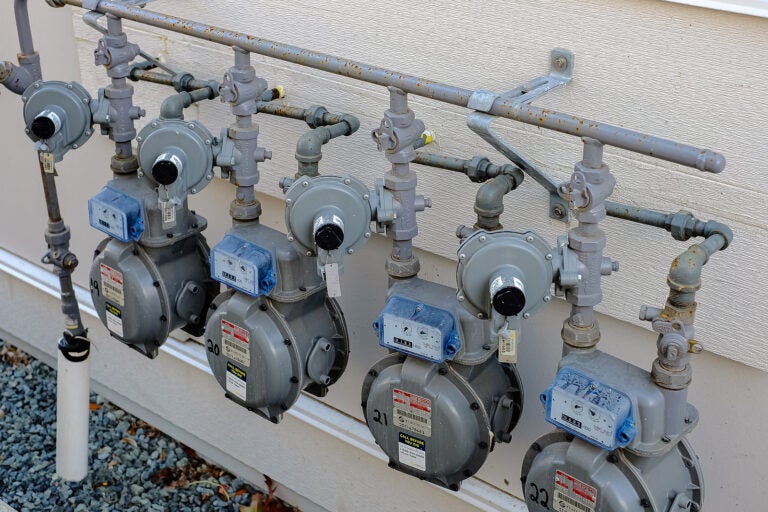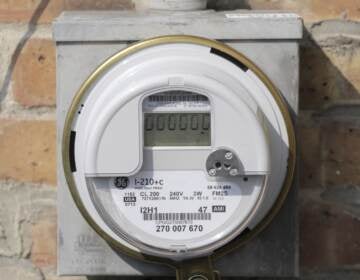PGW ordered to stop adjusting customers’ bills to account for May weather fluctuations
PGW’s weather normalization adjustment has cost customers millions in recent years. Advocates say a new change doesn't go far enough.
Listen 1:16
Residential gas meter (Elena_Alex_photo/BigStock)
From Philly and the Pa. suburbs to South Jersey and Delaware, what would you like WHYY News to cover? Let us know!
More than a year after some Philadelphians received shockingly high gas bills during a month when people tend to use little heat, state utility regulators have ordered Philadelphia Gas Works to tweak one of its billing practices.
PGW will stop adjusting customers’ bills to account for weather fluctuations during the month of May. But advocates for low-income utility customers say the change doesn’t go far enough.
“This doesn’t resolve the structural problems in how the [weather normalization adjustment] operates,” said Robert Ballenger, an attorney with Community Legal Services representing the Tenant Union Representative Network. “Allowing that to continue, to us, is really questionable.”
The weather normalization adjustment is a billing tool PGW has used for more than 20 years to smooth its revenue when temperature fluctuations mean customers use more or less heat than usual.
The utility credits customers when a month is colder than normal, compared to a 20-year historical average, and charges customers when a month is warmer than normal. The adjustment has traditionally applied during the months of October through May.
PGW is one of four utilities in Pennsylvania that use a weather normalization adjustment. Records show the adjustment has cost PGW customers tens of millions of dollars in recent years, and critics say it is unfair as temperatures rise due to climate change.
The adjustment came under scrutiny in May 2022, when some PGW customers received puzzlingly high gas bills — some hundreds of dollars — after a string of unseasonably warm days caused weather normalization adjustment charges to spike.
At the time, PGW’s president said the formula performed as designed, but had an unfair impact. PGW refunded customers more than $12 million and promised an internal investigation into the adjustment’s formula and inputs for May.
During a public hearing before the Pennsylvania Public Utility Commission about PGW’s weather normalization adjustment in March, customers criticized the billing practice as charging households for gas they don’t use. Some testified that the tool protects PGW from the costs of climate change while customers foot the bill.
“PGW is charging folks who can least afford it, through no fault of their own, the costs of experiencing warmer winters,” Pamela Darville, a PGW customer, civil rights lawyer, and member of the activist group POWER, said at the time. “This is inherently unfair and unjust.”
Winter is the fastest warming season across much of the country and in Pennsylvania. An analysis by the nonprofit research group Climate Central shows Philly’s average winter temperature has increased by around 5 degrees Fahrenheit since 1970.
In recent years, the credits and charges associated with PGW’s weather normalization adjustment have not evened out. In four of the last five fiscal years for which reports are available on the PUC website, PGW has on net charged customers — for a total of more than $43 million.
In a press release in 2021, the PUC said it “encourage[s] other utilities to explore” using a weather normalization adjustment. Since last September, the PUC has approved two more gas utilities — National Fuel and UGI Utilities — to join PGW and Columbia Gas in trying out a weather normalization adjustment.
PGW defends its weather normalization adjustment as key to its financial stability and ability to keep its base rates “as low as possible.”
In response to the high bills in May 2022, PGW requested approval from the PUC to cap its adjustment at no more than 25% of a customer’s total delivery charges, excluding the weather normalization adjustment, on any bill.
The Coalition for Affordable Utility Services and Energy Efficiency in Pennsylvania and Tenant Union Representative Network argued PGW should drop the adjustment entirely, because it has resulted in higher charges for some customers than for others, based on their billing cycles. In a filing this summer, the groups called the adjustment “unlawfully discriminatory.”
An Administrative Law Judge overseeing the proceeding recommended the PUC order PGW to drop the adjustment just during the month of May. The PUC unanimously approved this recommendation Thursday.
According to the PUC’s order, PGW had found that temperatures for the month of May over the past 10 years have become “unusually divergent from the current normal.”
In a statement, a spokesperson for PGW said the outcome supports the weather normalization adjustment’s “intended function of protecting customers from significant billing fluctuations.”
Ballenger, the attorney representing the Tenant Union Representative Network, said allowing PGW to continue using the weather normalization adjustment October through April means problems could still arise.
“We could experience the same kind of drastic disparity in October that we experienced in May of last year, because the mechanism is no different,” he said.
The order the PUC passed Thursday does specify that the adjustment must be addressed in PGW’s next rate case.

Subscribe to PlanPhilly
WHYY is your source for fact-based, in-depth journalism and information. As a nonprofit organization, we rely on financial support from readers like you. Please give today.







